Scottish Crime and Justice Survey 2019/20: main findings
Main findings from the Scottish Crime and Justice Survey 2019/2020, including self-completion findings covering the period 2018/19 to 2019/20.
This document is part of a collection
9.3 Partner Abuse
Respondents to the SCJS are asked about their experiences of partner[154] abuse since the age of 16 and in the 12 months prior to interview, both psychological and physical.
Partner abuse in the SCJS is defined as 'any form of physical, non-physical or sexual abuse, which takes place within the context of a close relationship, committed either in the home or elsewhere. This relationship will be between partners (married, co-habiting or otherwise) or ex-partners'. This definition is consistent with the definition adopted by Police Scotland in recording domestic violence.[155]
The definition of partner abuse in Scotland also includes psychological abuse in accordance with the Domestic Abuse (Scotland) Act 2018.[156] The types of psychological abuse asked about in the survey capture some elements of this. However stakeholder engagement is ongoing to review the partner abuse section of the survey and considering whether the question set should be updated.
The definition of partner abuse is not introduced at the start of the survey and the terms 'partner abuse' or 'domestic abuse' are not used in the survey until the final question of the section. Rather, respondents are asked to identify which, if any, of the following psychological and physical abusive behaviours they have experienced since the age of 16, and in the 12 months prior to interview:
Psychological partner abuse
Has any partner or ex-partner ever done any of the following things to you:
- stopped you having your fair share of the household money or taken money from you
- stopped you from seeing friends and relatives
- repeatedly put you down so that you felt worthless
- behaved in a jealous or controlling way
- forced you to view material which you considered to be pornography
- threatened to kill or attempted to kill themselves as a way of making you do something or stopping you from doing something
- threatened to, attempted to or actually hurt themselves as a way of making you do something or stopping you from doing something
- threatened you with a weapon, for example, a knife, an ashtray or a bottle
- threatened to hurt you
- threatened to hurt someone close to you, such as your children, family members, friends or pets
- threatened to hurt your other/previous partner
- threatened to kill you
Physical partner abuse
Has any partner or ex-partner ever done any of the following things to you:
- pushed you or held you down
- kicked, bitten, or hit you
- thrown something at you with the intention of causing harm
- choked or tried to strangle/smother you
- used a weapon against you, for example, a knife, an ashtray or a bottle
- forced you or tried to force you to have sexual intercourse when you did not want to
- forced you or tried to force you to take part in another sexual activity when you did not want to
There may be some overlap between the incidents of partner abuse presented in this section, and the incidents of stalking and harassment and sexual victimisation discussed elsewhere in this report, as these experiences can involve similar behaviours. It is also possible that some partner abuse incidents presented in this section constituted sexual victimisation and/or stalking and harassment but were not viewed or reported during the survey as such by respondents.
The figures in this section refer to the two survey years 2018/19 and 2019/20 combined. This is referred to throughout the section as 2018/20. For more information, see the Technical Report.
What can the 2018/20 SCJS results tell us about partner abuse in Scotland?
In 2018/20, 16.5% of adults said they had experienced at least one incident of partner abuse since the age of 16.
Overall, 16.5% of respondents[157] said they experienced at least one form of partner abuse, either psychological or physical, since the age of 16. This is a decrease since 2008/09 (18.2%), but unchanged since 2016/18 (15.6%).
Table 9.4 shows the time series since 2008/09. As this is a lifetime measurement, it would not be expected to change much, if at all, over this relatively short period of time, therefore it is recommended any changes are interpreted with caution.
There have been no statistically significant changes between 2016/18 and 2018/20 in the proportion of respondents experiencing any types of partner abuse since the age of 16.
| Abuse type | 2008/09 | 2009/10 | 2010/11 | 2012/13 | 2014/15 | 2016/18 | 2018/20 | Percentage point change |
|---|---|---|---|---|---|---|---|---|
| since 2008/09 | ||||||||
| Psychological abuse | 15.1% | 13.4% | 13.4% | 12.0% | 12.2% | 13.8% | 14.6% | No change |
| Physical abuse | 13.2% | 11.9% | 12.0% | 9.2% | 9.6% | 10.2% | 10.7% | ↓ by 2.5 |
| Both psychological and physical abuse | 10.0% | 8.9% | 9.1% | 7.4% | 7.7% | 8.4% | 8.8% | ↓ by 1.2 |
| Any psychological or physical abuse | 18.2% | 16.4% | 16.3% | 13.8% | 14.1% | 15.6% | 16.5% | ↓ by 1.8 |
| Number of respondents | 10,110 | 12,730 | 10,400 | 9,650 | 9,310 | 8,110 | 8,850 |
Base: All respondents who have had a partner since the age of 16. Variables: DA_1i; DA_1ii; DA1iii; DA_1iv.
The proportion of respondents who said they had experienced at least one incident of psychological abuse since the age of 16 (14.6%) was higher than those reporting having experienced at least one incident of physical abuse (10.7%). 8.8% of respondents experienced both psychological and physical abuse.
Of respondents who had a partner or contact with an ex-partner in the 12 months prior to interview, 3.2% experienced at least one incident of partner abuse in the 12 months prior to interview; 2.9% had experienced psychological abuse; 1.3% had experienced physical abuse, and 1.0% had experienced both psychological and physical abuse. A higher proportion of respondents had experienced psychological abuse than physical abuse (Figure 9.7).
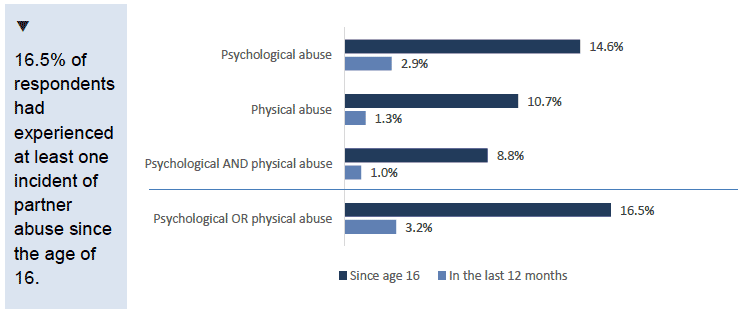
Base: All respondents who have had a partner since the age of 16 (8,850); all respondents who have had a partner or contact with an ex-partner in the 12 months prior to interview (6,550). Variables: DA_1i; DA_1iii.
Experiences of partner abuse in the 12 months prior to interview have decreased since 2008/09.
Table 9.5 below shows the trend in experiencing partner abuse in the 12 months prior to interview between 2008/09 and 2018/20.
Between 2008/09 and 2018/20, the proportion of respondents who had a partner, or contact with an ex-partner, in the 12 months prior to interview who experienced any partner abuse decreased from 4.2% to 3.2%. Looking at the two categories of partner abuse, the proportion experiencing psychological abuse remained stable (the apparent decrease from 3.4% to 2.9% is not statistically significant), whilst the proportion experiencing physical abuse decreased from 2.2% to 1.3%.
There have been no statistically significant changes between 2016/18 and 2018/20 in the proportion of respondents experiencing any types of partner abuse in the 12 months prior to interview.
| Abuse type | 2008/09 | 2009/10 | 2010/11 | 2012/13 | 2014/15 | 2016/18 | 2018/20 | Percentage point change |
|---|---|---|---|---|---|---|---|---|
| since 2008/09 | ||||||||
| Psychological abuse | 3.4% | 2.9% | 2.4% | 2.3% | 2.5% | 2.6% | 2.9% | No change |
| Physical abuse | 2.2% | 1.7% | 1.7% | 1.5% | 1.5% | 1.3% | 1.3% | ↓ by 0.9 |
| Both psychological and physical abuse | 1.4% | 1.1% | 1.1% | 1.0% | 1.0% | 0.9% | 1.0% | No change |
| Any psychological or physical abuse | 4.2% | 3.5% | 3.1% | 2.8% | 2.9% | 3.0% | 3.2% | ↓ by 1.0 |
| Number of respondents | 6,750 | 9,470 | 7,650 | 7,180 | 6,930 | 6,040 | 6,550 |
Base: All respondents who have had a partner or contact with an ex-partner in the 12 months prior to interview. Variables: DA_1i; DA_1ii; DA1iii; DA_1iv.
How often do people experience partner abuse and who are the offenders?
Partner abuse is often experienced on multiple occasions.
Around two-thirds (67%) of those who experienced an incident of partner abuse in the 12 months prior to interview also experienced at least one incident prior to this period.
Respondents who experienced partner abuse within the 12 months prior to interview were asked how many incidents of abuse they had experienced within this time period. Three-in-ten respondents (31%) who experienced partner abuse within the 12 months prior to interview had experienced more than one incident. Excluding those who responded "don't know/can't remember" or who did not wish to answer, around three-in-five respondents (59%) had experienced more than one incident.
Overall, 21% had experienced one incident, 8% experienced two incidents, 10% experienced three incidents, and 4% experienced four or more incidents. A further 9% said that there were too many incidents to count. Just over one-in-four respondents (27%) said that they either did not know or could not remember and just over one-in-five (21%) refused to answer this question (Figure 9.8).
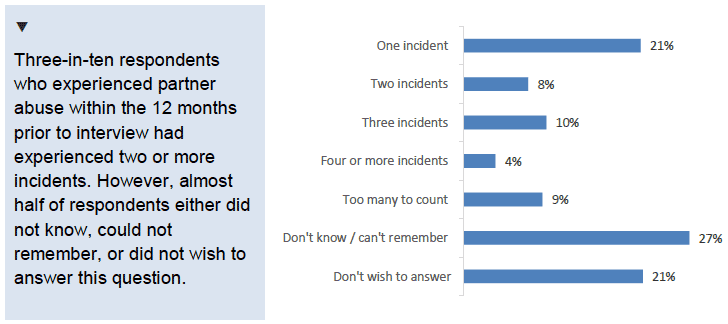
Base: All respondents experiencing at least one type of partner abuse in the 12 months prior to interview (200). Variable: DA_6.
Almost two-thirds of respondents reported having one abusive partner.
Of those who had experienced at least one incident of partner abuse since the age of 16, 62% reported having one abusive partner only. A further 11% reported that they had two abusive partners since they were 16, and 12% reported having had three or more abusive partners. The remaining respondents either did not wish to answer (9%) or did not know (7%).
Respondents were asked to state the gender of any abusive partners. Of those who had experienced partner abuse since the age of 16, 66% said the abuser was male, while 32% said the abuser was female. Less than 1% stated that both male and female partners had perpetuated abuse.
Breaking this down by the gender of respondents, Figure 9.9 shows that abusive partners were overwhelmingly of the opposite gender.
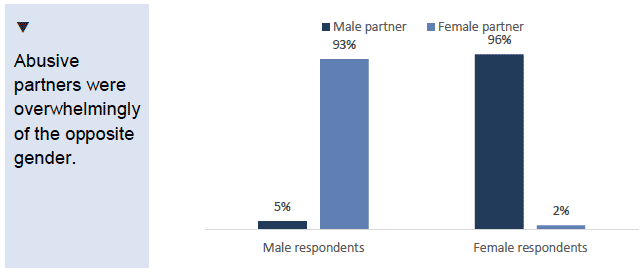
Base: All respondents experiencing at least one type of partner abuse since aged 16 (1,500). Variable: DA_1vi.
Are some population groups more likely to have experienced partner abuse?
This section examines the relationship between gender, age, victim status,[160] area deprivation and rurality on experience of partner abuse, both since the age of 16 and in the 12 months prior to interview.
When looking at age, the results have also been broken down by both age and gender, as there are notable differences in partner abuse between genders within different age groups.
Changes over time are also discussed below where they have occurred, however most groups have shown no significant change in the longer term and none of the groups have shown any change since 2016/18.
Gender
Table 9.6 below shows how the proportion of respondents experiencing partner abuse varied by gender.
Since the age of 16, women were almost twice as likely as men to have experienced partner abuse (21.2% and 11.2% respectively), similar to the position in previous years. A higher proportion of women than men reported psychological abuse, physical abuse, and both psychological and physical abuse since the age of 16.
When looking at experiences of types of partner abuse in the 12 month period prior to interview, experiences of partner abuse were more common for women than men (3.7% and 2.6% respectively). This has been the case since 2014/15. Women were more likely to experience psychological abuse than men (3.4% and 2.4% respectively). However, the proportion who experienced physical abuse did not vary between women and men (1.5% and 1.0% respectively).
| Since age 16 | In the 12 months prior to interview | |||
|---|---|---|---|---|
| Male | Female | Male | Female | |
| Psychological abuse | 9.3% | 19.3% | 2.4% | 3.4% |
| Physical abuse | 6.7% | 14.4% | 1.0% | 1.5% |
| Both psychological and physical abuse | 4.8% | 12.5% | 0.8% | 1.3% |
| Any psychological or physical abuse | 11.2% | 21.2% | 2.6% | 3.7% |
Base: All male respondents who have had a partner since age 16 (3,980); all female respondents who have had a partner since age 16 (4,860); all male respondents who have had a partner or contact with an ex-partner in the 12 months prior to interview (3,130); all female respondents who have had a partner or contact with an ex-partner in the 12 months prior to interview (3,420). Variables: DA_1i; DA_1ii; DA1iii; DA_1iv.
Age
Table 9.7 below shows how the proportion of respondents who experienced partner abuse, varied with age. As in previous years (with exception of 2012/13), experience of partner abuse in the 12 months prior to interview was highest amongst the 16 to 24 year age-group (9.4%).
| Since age 16 | In the 12 months prior to interview | |
|---|---|---|
| 16 to 24 years | 21.6% | 9.4% |
| 25 to 44 years | 21.3% | 4.3% |
| 45 to 59 years | 18.5% | 2.2% |
| 60 years and over | 8.1% | 0.5% |
Base: All respondents who have had a partner since age 16 aged 16-24 (500); 25-44 (2,600); 45-59 (2,380); 60+ (3,370); all respondents who have had a partner or contact with an ex-partner in the 12 months prior to interview aged 16-24 (410); 25-44 (2,230); 45-59 (1,880); 60+ (2,040). Variables: DA_1i; DA_1ii; DA1iii; DA_1iv.
Table 9.8 below shows experience of partner abuse broken down further, by age within gender. As in previous years, since the age of 16, women were more likely to have experienced partner abuse than men for all the age categories. Within the 12 months prior to interview women aged 16 to 24 were more likely than any other age group of women to have experienced partner abuse (10.2%). Within this time period there was no significant difference between men and women aged 16 to 24.
| Since age 16 | In the 12 months prior to interview | |||
|---|---|---|---|---|
| Male | Female | Male | Female | |
| 16 to 24 years | 16.9% | 25.7% | 8.4% | 10.2% |
| 25 to 44 years | 14.6% | 27.6% | 3.7% | 4.9% |
| 45 to 59 years | 13.2% | 23.3% | 2.2% | 2.2% |
| 60 years and over | 3.9% | 11.6% | 0.2% | 0.7% |
Base: All male respondents who have had a partner since age 16 aged 16-24 (210); 25-44 (1,130); 45-59 (1,090); 60+ (1,550); all female respondents who have had a partner since age 16 aged 16-24 (290); 25-44 (1,470); 45-59 (1,280); 60+ (1,820); all male respondents who have had a partner or contact with an ex-partner in the 12 months prior to interview aged 16-24 (160); 25-44 (960); 45-59 (880); 60+ (1,130); all female respondents who have had a partner or contact with an ex-partner in the 12 months prior to interview aged 16-24 (250); 25-44 (1,270); 45-59 (1,000); 60+ (910). Variables: DA_1i; DA_1ii; DA1iii; DA_1iv.
Victim status
Experience of partner abuse was associated with other types of victimisation. Over a quarter (28.1%) of those who were classified as victims[161] in the main SCJS survey[162] had experienced partner abuse since the age of 16, and 14.9% of non-victims, in line with previous years. Of those who had experienced at least one type of partner abuse in the 12 months prior to interview, 7.0% were classified as victims of crime in the main SCJS survey, compared to 2.6% of those who were not classified as victims, consistent with previous years.
Area deprivation
As has been the case in previous years, experience of partner abuse since the age of 16 varied significantly in terms of area deprivation. Over one-in-five (21.6%) of those living in the 15% most deprived areas of Scotland reported abuse since age 16, compared to 15.7% of those living in the rest of Scotland. No difference was found in 2018/20 by area deprivation in experience of partner abuse in the 12 months prior to interview (3.6% and 3.1% respectively).
Rurality
No difference was detected in the likelihood of having experienced partner abuse by urban and rural location, both since the age of 16 (16.6% and 15.6%, respectively) and in the 12 months prior to interview (3.2% and 3.0%, respectively).
What can the 2018/20 SCJS results tell us about the types partner abuse most commonly experienced?
To capture experiences of partner abuse as fully as possible, this section focuses on partner abuse experienced since the age of 16.
The most commonly reported type of psychological abuse experienced was a partner acting in a jealous or controlling way.
Respondents were asked if they had experienced twelve different types of psychological abuse since the age of 16, as outlined earlier.
Overall, the most commonly reported form of psychological abuse was a partner behaving in a jealous or controlling way (9.5%), followed by repeatedly put down so made to feel worthless (8.4%). A further 5.4% stated that a partner had stopped them from seeing friends and relatives, and 4.8% also said that a partner had threatened to hurt them.
However, these findings differed by gender of the respondent, with the proportion of women reporting abuse higher than the proportion of men for each of the twelve types. Figure 9.10 shows the percentage of respondents experiencing different types of psychological abuse since the age of 16, broken down by gender.
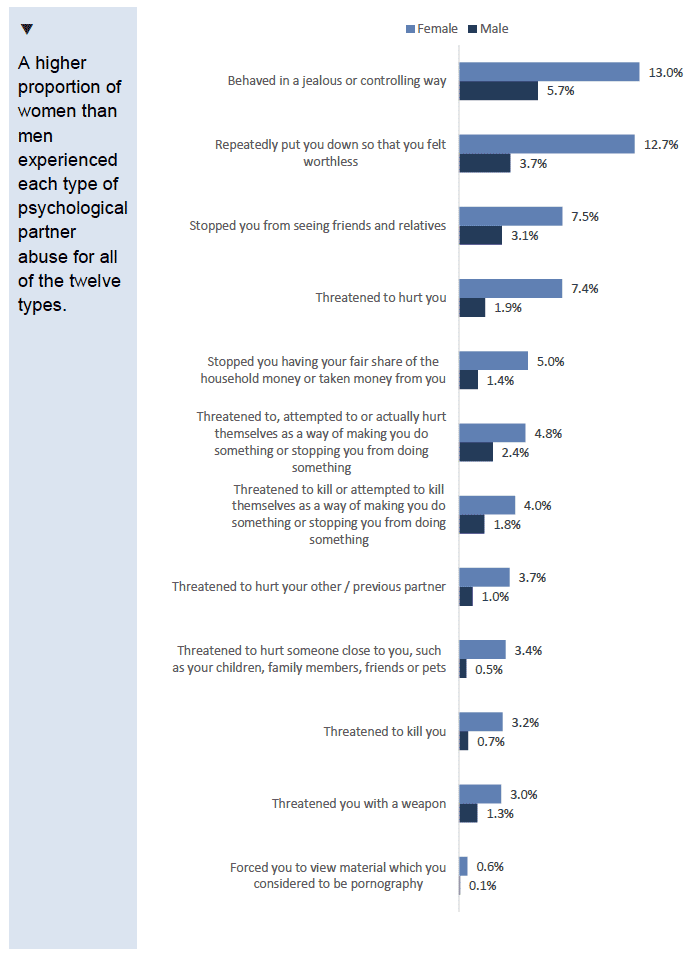
Base: All male respondents who have had a partner since age of 16 (3,980); all female respondents who have had a partner since age 16 (4,860). Variable: DA_1i.
The most commonly reported types of physical partner abuse experienced were being kicked, bitten or hit, being pushed or held down, and having something thrown at them with the intention of causing harm.
Respondents were asked if they had experienced seven different types of physical abuse since the age of 16, as outlined earlier.
Overall, the most commonly reported forms of physical partner abuse experienced by respondents were being kicked, bitten or hit (5.9%), being pushed or held down (5.5%), and having something thrown at them with the intention of causing harm (5.3%).
However, these findings differed by gender, with the proportion of women reporting abuse higher than the proportion of men for each of the seven types. Figure 9.11 below shows the percentage of respondents experiencing different types of physical abuse since the age of 16, broken down by gender.
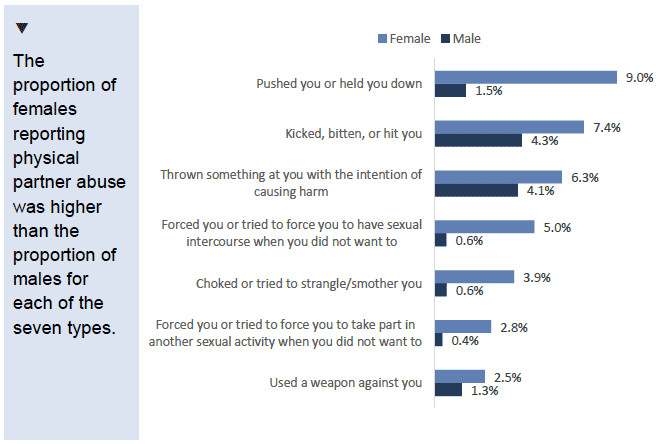
Base: All male respondents who have had a partner since age of 16 (3,980); all female respondents who have had a partner since age 16 (4,860). Variable: DA_1iii.
What can the SCJS tell us about the impact of partner abuse?
Respondents who experienced at least one incident of partner abuse in the 12 months prior to interview were asked if they had experienced a range of effects, both psychological and physical, as a result of the most recent (or only) incident of abuse.
Three-in-four of those experiencing partner abuse had at least one psychological effect as a result of the most recent (or only) incident of abuse in the 12 months prior to interview.
Three-in-four adults (74%) with experience of partner abuse in the 12 months prior to interview reported psychological effects of some sort, with no significant difference found between men and women.
A range of psychological effects were reported, including low self-esteem (49%), depression (38%), and anxiety/panic attacks (32%).
Women were more likely than men to have experienced three of the twelve effects:
- anxiety/panic attacks (42% of women, compared to 17% of men)
- fear (25% compared to 10%)
- isolation from family or friends (21% compared to 9%)
As most differences by gender in the 12 months prior to interview are not statistically significant, Figure 9.12 below shows the psychological effects experienced for all adults. Results split by gender, along with other demographic and area breakdowns, are provided in the online data tables.
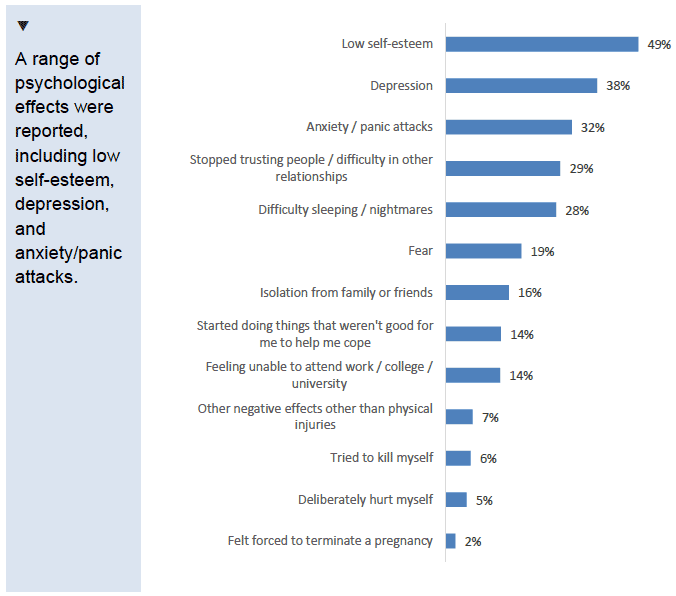
Base: All respondents who experienced at least one type of partner abuse in the 12 months prior to interview (200). Variable: DA_9
Just over a third of those experiencing partner abuse (either physical or psychological) in the 12 months prior to interview had at least one physical effect of the abuse as a result of the most recent (or only) incident.
Physical impacts were reported by just over one-third (34%) of adults experiencing partner abuse in the 12 months prior to interview. There was no statistically significant difference between the proportion of men (38%) and women (32%) who reported at least one physical effect of the most recent (or only) incident of partner abuse.
A range of physical effects were reported, including minor bruising or black eye (17%), scratches or minor cuts (14%) and severe bruising (7%).
46% of those who had experienced at least one incident of partner abuse since age 16 considered themselves to have ever been a victim of domestic abuse.
Almost half (46%) of adults with experience of partner abuse since the age of 16 assessed that they had been a victim of domestic abuse.
Of those who experienced physical abuse in the 12 months prior to interview, almost half (45%) viewed this as a crime, compared to 24% who viewed their experiences of psychological abuse (in the 12 months prior to interview) as a crime.
What can the SCJS tell us about the circumstances in which partner abuse occurs and how often it is reported?
Respondents who experienced partner abuse in the 12 months prior to interview were asked about the circumstances of the most recent (or only) incident of partner abuse and who, if anyone, they had told about their experience. The section below presents a high-level summary of some of the information provided by respondents. Further results are available in the supporting data tables. It is important to note that the latest incident might not be the most serious and also may not be representative of all incidents of partner abuse a respondent experienced.
41% were living with the partner at the time of the incident.
- Of those, just over two-fifths (42%) said they were still living with the abusive partner at the time of the survey interview.
Around a third said that children were living in their household when the incident took place.
- Of those who reported children were living in the household (32%), 71% said that the children were present (in or around the house or close by) during the most recent incident.
Over two-thirds (68%) had told at least one person or organisation about the most recent incident, unchanged from 2016/18.
- A higher proportion of women than men had told at least one person or organisation about their experiences of abuse (76% and 55%, respectively).
- There are a range of different people and services that those who have experienced partner abuse reported engaging with. Respondents were most likely to have told friends (45%) and relatives (21%) about the most recent incident of abuse. Around three-in-ten respondents (29%) said they had told none of the people or organisations asked about, whilst around one-in-ten reported the incident to the police, or told a doctor (11% and 10%, respectively). These percentages are not statistically different from 2016/18.
The police came to know about under one-in-five of the most recent incidents of partner abuse.
- 16% said that the police came to know about the most recent (or only) incident of partner abuse somehow, unchanged from 2016/18. This differs from the 11% figure in the paragraph above, as it includes incidents the police came to know about through any means, including via neighbours and relatives, not just reported by the respondent themselves.
Contact
Email: scjs@gov.scot
There is a problem
Thanks for your feedback